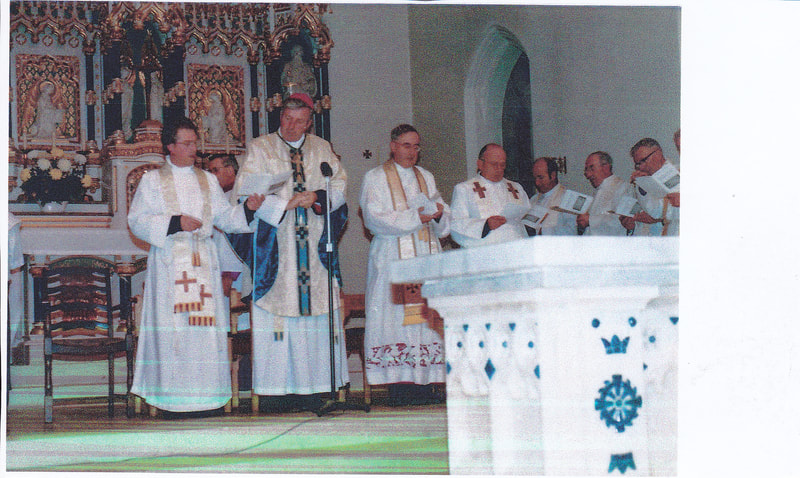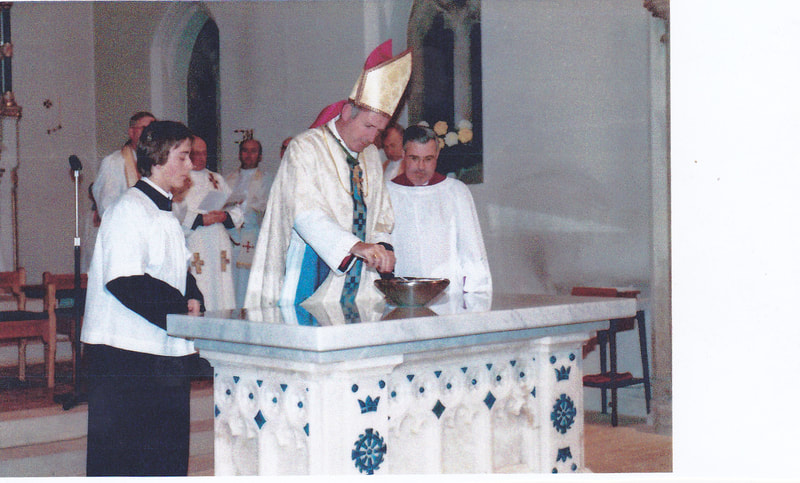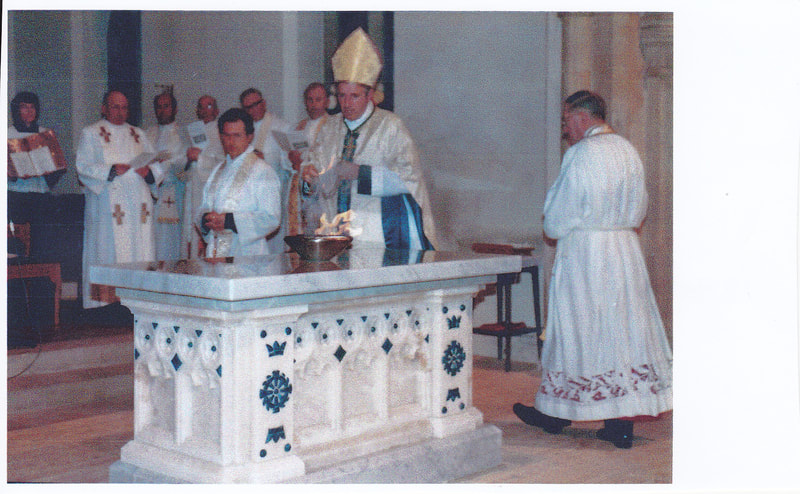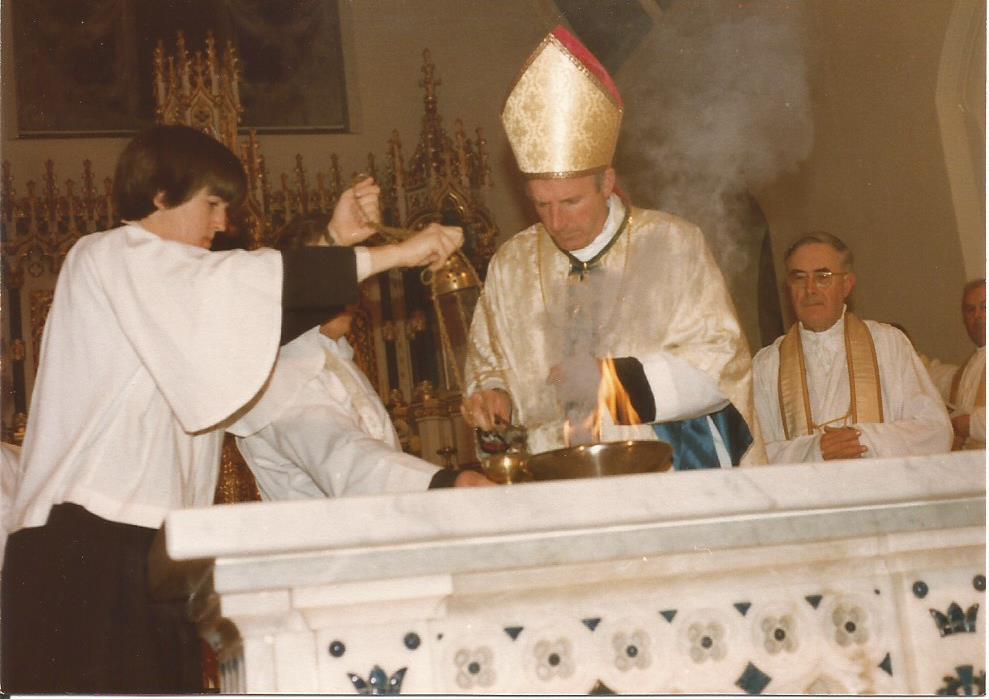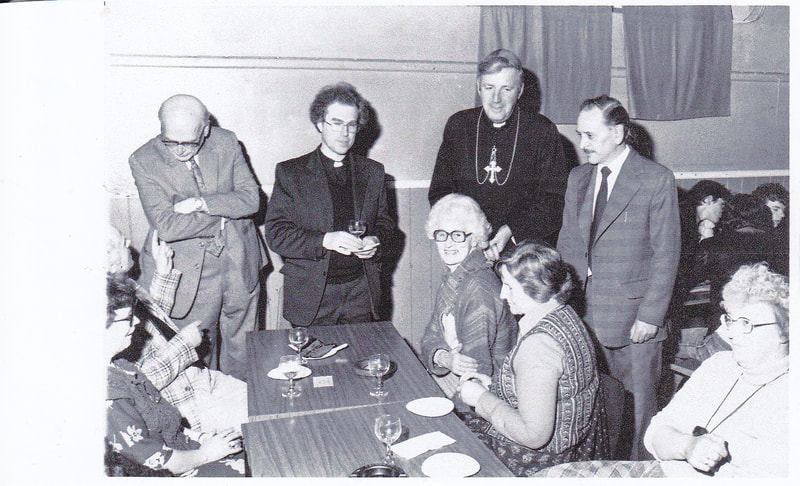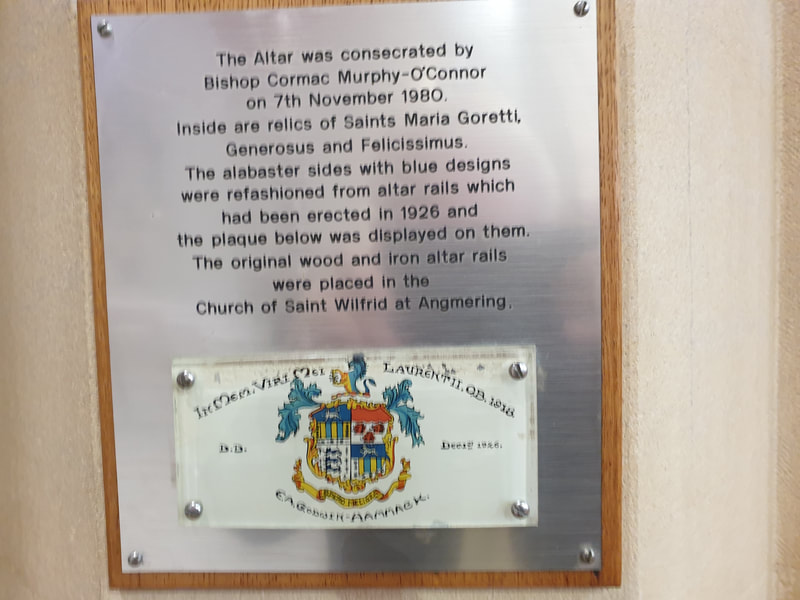The Dedication of the New Altar
Friday 7 November 1980
Credits: pictures 1-4 by the Kates family, picture 5 by the Crayden family.
The Reason for a New Altar in 1980
The reform of the Roman Rite of Mass that was carried out after the Second Vatican Council significantly altered the shape of Catholic worship. One of the most evident changes was the construction of freestanding altars. At St Catherine’s in the mid-70s a temporary altar was placed, for some months, in the middle of the church, with the benches arranged around it. When this was found to be impracticable, the current layout was introduced. The sanctuary was extended and a new altar, using the 1926 marble altar rails, was constructed.
This altar was “consecrated” (or, as we say now, “dedicated”) in a Mass concelebrated by Bishop Cormac Murphy O’Connor with the priests of the parish, Mgr Paul Clark and Fr Ralph Message, in the presence of other priests of the Deanery. The M.C. was, coincidentally, Fr Richard Veal, later an assistant priest here.
The Transfer of the Relics
After the homily and profession of faith, a Litany of the Saints was sung. Then the relics of three martyrs were placed in the new altar. This signified that all who have been baptised in the death of Christ, especially those who have shed their blood for the Lord, share in Christ’s passion.
These relics were of:
The Four Rites
After the Prayer of Dedication, the altar was anointed with chrism, making it a symbol of Christ.
Incense was then burned on the altar in a brazier, signifying Christ’s sacrifice ascending to the Father, along with the people’s prayers. Some of this incense was then transferred to the censer [or thurible], to be used in the censing of the congregation.
The altar was then covered – prepared as a table of the sacrificial banquet and adorned as for a feast.
Finally, the altar was lit, as Christ is “a light to enlighten the nations”. After this, the Eucharist was celebrated.
After Mass, a get-together was held in the Parish Social Club (then using the premises of the old Primary School – where St Catherine’s Court now stands – as the new Parish Centre had not yet been completed).
Please roll over a picture for its caption, and left click on a picture to expand it.
The reform of the Roman Rite of Mass that was carried out after the Second Vatican Council significantly altered the shape of Catholic worship. One of the most evident changes was the construction of freestanding altars. At St Catherine’s in the mid-70s a temporary altar was placed, for some months, in the middle of the church, with the benches arranged around it. When this was found to be impracticable, the current layout was introduced. The sanctuary was extended and a new altar, using the 1926 marble altar rails, was constructed.
This altar was “consecrated” (or, as we say now, “dedicated”) in a Mass concelebrated by Bishop Cormac Murphy O’Connor with the priests of the parish, Mgr Paul Clark and Fr Ralph Message, in the presence of other priests of the Deanery. The M.C. was, coincidentally, Fr Richard Veal, later an assistant priest here.
The Transfer of the Relics
After the homily and profession of faith, a Litany of the Saints was sung. Then the relics of three martyrs were placed in the new altar. This signified that all who have been baptised in the death of Christ, especially those who have shed their blood for the Lord, share in Christ’s passion.
These relics were of:
- St Felicissimus (feast day 7 Aug), one of the Six Deacons of Pope Sixtus II martyred with him on 6 Aug 258. (Lawrence, the more famous 7th Deacon, was martyred a month later)
- St Generosus, an early martyr in Tivoli, where his relics are enshrined
- St Maria Goretti 1890-1902 (feast day 6 July), a devout 11 year-old girl from near Anzio who had been murdered whilst resisting rape. Canonised in 1950.
The Four Rites
After the Prayer of Dedication, the altar was anointed with chrism, making it a symbol of Christ.
Incense was then burned on the altar in a brazier, signifying Christ’s sacrifice ascending to the Father, along with the people’s prayers. Some of this incense was then transferred to the censer [or thurible], to be used in the censing of the congregation.
The altar was then covered – prepared as a table of the sacrificial banquet and adorned as for a feast.
Finally, the altar was lit, as Christ is “a light to enlighten the nations”. After this, the Eucharist was celebrated.
After Mass, a get-together was held in the Parish Social Club (then using the premises of the old Primary School – where St Catherine’s Court now stands – as the new Parish Centre had not yet been completed).
Please roll over a picture for its caption, and left click on a picture to expand it.
Mike Webber
Sources:
1 "Rite of Dedication of a Church and an Altar", English translation copyright 1978, International Committee on English in the Liturgy, Inc (ICEL).
2 Oxford Dictionary of Saints, David Farmer, 2011.
Sources:
1 "Rite of Dedication of a Church and an Altar", English translation copyright 1978, International Committee on English in the Liturgy, Inc (ICEL).
2 Oxford Dictionary of Saints, David Farmer, 2011.
